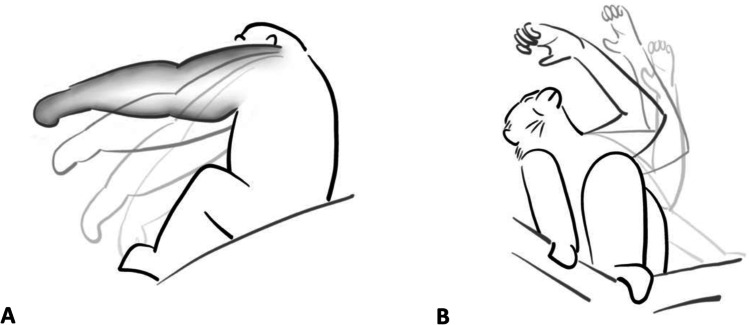Fig. 2.
Illustration of the different stroke phases of variable and stable gesture action types using ‘reach’ and ‘beckon’ as examples. Note. We assume that the information content within a gesture action may not be evenly spread over the whole gesture duration but may take more the form of discrete units (e.g., action and hold) and illustrate this with two example gesture actions. A ‘Reach’ (a variable gesture action type): the minimum action unit (MAU) and the gesture action (GA) start as soon as the signaller moves his arm from the neutral position (very light grey line), i.e., starts to gesture. The MAU ends when the movement phase is completed, i.e., the reach is in its maximal extension towards the recipient (dark grey line; MAU duration = neutral position to MAU end). The gesture action continues until the signaller starts to lower their arm, i.e., when the gesture is not in place anymore. This optional hold phase between the end of the MAU and the end of the GA is indicated by the grey airbrush fill (Gesture action duration = neutral position to GA end, i.e., end of hold/repetition phase). We also annotate when the arm is back in its neutral position to track the total time invested in the gesture production (Full gesture duration = neutral position to neutral position). B ‘Beckon’ (a stable gesture action type): the MAU and the GA start as soon as the signaller moves his arm from the neutral position (very light grey line), i.e., starts to gesture. The MAU ends when the movement phase is completed (i.e., after the full scooping beckon action). As this is a stable gesture action, there is no optional hold/repetition phase, and the gesture action ends at the same time as the MAU (MAU/GA duration = neutral position to MAU/GA end). As in the reach, we also annotate the time when the arm is back in its neutral position (Gesture duration = neutral position to neutral position)

